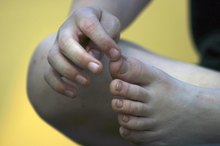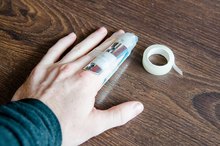Homemade Bandages
You may need to make a homemade bandage in an emergency situation when you have no ready-made first aid materials available. Some people also like to make their own bandages for cost or environmental reasons. Homemade bandages are much cheaper than over-the-counter alternatives, and allow you to use materials that would otherwise be thrown away.
Making an Emergency Bandage
Find some gauze to use as a dressing for the wound. If gauze is not available, use a paper towel.
How to Make a Roomy Slingback Fit Better
Learn More
Find some sticky tape. Any kind will do. It will be used to hold the dressing in place.
Cut or tear the gauze or paper towel into the right shape and size for the wound you are dressing. It will need to cover the wound completely with some left over around the edges. Clean the wound, then place the dressing on it.
How to Remove Bandage Adhesive From Skin
Learn More
Stick tape firmly over the dressing to hold it in position. Some pressure is needed on the dressing to stem the bleeding.
- Find some gauze to use as a dressing for the wound.
- Clean the wound, then place the dressing on it.
Bandages for Your Medicine Cabinet
Make a compress or rolled bandage out of an old white cotton sheet. Cut the sheet into long strips of at least 5 feet in length. Widths should be 1 inch, 2 inches and 3 inches. Roll the strips up so they will be ready to use to keep dressings in place. These compress bandages should be sterile because they are likely to come into contact with a fresh wound. Store them in a plastic freezer bag to keep them sterile.
Make a triangular bandage out of any strong cotton material. Cut a triangle out of the cloth with a base of 55 inches and sides of 40 inches. Hem the edges so that it will last a long time. A triangular bandage can be used as a sling or as a tourniquet along with a piece of cane, the shaft of a screwdriver or another tool that you may have available. You can tie the triangular bandage around the limb above the wound, thread the cane or tool through the bandage, and turn it so that the bandage tightens, restricting the flow of blood into the limb . The bandage can even be used as an emergency napkin for a child, or as a scarf on a windy day. Triangular bandages need to be clean, but not necessarily sterile, as they won't come into close contact with open wounds.
Cut a variety of widths from the legs of some old stretch jeans to make elastic bandages. Once you have cut the widths, sew them together so that they can fit fairly tightly around an arm or a leg to hold a splint in place or to support a sprained ankle. Elastic bandages should be clean, but do not need to be sterilized.
Cut lengths from the legs of support pantyhose for tube bandages, which are used on hard-to-bandage, bendable areas like knees and elbows. You can also bandage a hand by pulling the tubing over the hand and cutting small holes for the fingers to fit through.
Tips
When making an emergency bandage, use a piece of cloth, such as a strip torn from an old sheet or shirt, to hold the dressing in place if you can't find any sticky tape.
Warnings
Bandages that will be near or in contact with wounds should be made of white material so that no dye gets into the wound.
When making an emergency dressing, do not use toilet paper instead of a paper towel or gauze. It is too weak and bits may come away and get stuck in the wound.
- Make a compress or rolled bandage out of an old white cotton sheet.
- Once you have cut the widths, sew them together so that they can fit fairly tightly around an arm or a leg to hold a splint in place or to support a sprained ankle.
Related Articles
References
- Day MW. Control of Traumatic Extremity Hemorrhage. Crit Care Nurse. 2016;36(1):40-51. doi:10.4037/ccn2016871
- Drew B, Bennett BL, Littlejohn L. Application of current hemorrhage control techniques for backcountry care: part one, tourniquets and hemorrhage control adjuncts. Wilderness Environ Med. 2015;26(2):236-45. doi:10.1016/j.wem.2014.08.016
- Littlejohn L, Bennett BL, Drew B. Application of current hemorrhage control techniques for backcountry care: part two, hemostatic dressings and other adjuncts. Wilderness Environ Med. 2015;26(2):246-54. doi:10.1016/j.wem.2014.08.018
- Navarro A, Brooks A. Use of local pro-coagulant haemostatic agents for intra-cavity control of haemorrhage after trauma. Eur J Trauma Emerg Surg. 2015;41(5):493-500. doi:10.1007/s00068-014-0441-4
Writer Bio
Steve Sparkes started writing professionally in 1982. He was a journalist and photographer for "The New York Waste" magazine for a decade. Sparkes has a diploma of art and design and a Bachelor of Arts in history of art from the South-East Essex School of Art. He also has a Master of Arts in photography from the London School of Printing and Graphic Arts.







